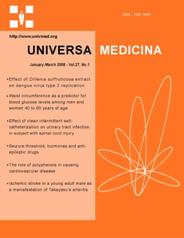Waist circumference as a predictor for blood glucose levels among men and women 40 to 60 years of age
Main Article Content
Abstract
Article Details
Issue
Section
The journal allows the authors to hold the copyright without restrictions and allow the authors to retain publishing rights without restrictions.
How to Cite
References
Wild S, Roglic G, Green A, Sicree R, King H. Global prevalence of diabetes: estimates for the year 2000 and projections for 2030. Diabetes Care 2004; 27: 1047–53.
Aekplakorn W, Stolk RP, Neal B, Suriyawongpaisal P, Chongsuvivawong V, et al . The prevalence and management of diabetes in Thai adults: the International Collaborative Study of Cardiovascular Disease in Asia. Diabetes Care 2003; 26: 2758–63.
Departemen Kesehatan Republik Indonesia. Jumlah penderita diabetes Indonesia ranking ke-4 di dunia. Available at: http://www.depkes.go.id/index.php?option=news&task=viewarticle&sid=1183. Accessed August 12, 2007.
King H, Aubert RE, Herman WH. Global burden of diabetes, 1995–2025: prevalence, numerical estimates, and projections. Diabetes Care 1998; 21: 1414–31.
Must A, Spadano J, Coakley EH, Field AE, Colditz G, Dietz WH. The disease burden associated with overweight and obesity. JAMA 1999; 282: 1523-9.
US National Institutes of Health. Clinical guidelines for the identification, evaluation, and treatment of overweight and obesity in adults. National Institutes of Health: Bethesda, MD; 1998.
World Health Organization. Obesity. Preventing and managing the global epidemic. Report of a WHO Consultation on Obesity, Geneva, 3–5 June. World Health Organization: Geneva; 1998.
Okosun IS, Liao Y, Rotimi CN, Choi S, Cooper RS. Predictive values of waist circumference for dyslipidaemia, type 2 diabetes and hypertension in overweight White, Black, and Hispanic American adults. J Clin Epidemiol 2000; 53: 401– 8.
Goyder E, Irwig L. Screening for diabetes: what are we really doing? Br M J 1998; 317: 1644-6.
American Diabetes Association. Diagnosis and classification of diabetes mellitus. Diabetes Care 2005; 28 (Suppl 1): S37-S42.
A Berber A , Go´mez-Santos R, Fangha¨nel G, Sa´nchez-Reyes L. Anthropometric indexes in the prediction of type 2 diabetes mellitus, hypertension and dyslipidaemia in a Mexican population. Int J Obes 2001; 25: 1794–9.
Harris MI, Flegal KM, Cowie CC, Eberhardt MS, Goldstein DE, Little RR, et al. Prevalence of diabetes, impaired fasting glucose, and impaired glucose tolerance in U.S. adults. Third National Health and Nutrition Examination Survey, 1988 – 1994. Diabetes Care 1998; 21: 518–24.
Delima. Indeks antropometri sebagai uji diagnostic diabetes mellitus tipe 2. Avaiable at: http://digilib. litbang.depkes.go.id/go.php?id= jkpkbppk-gdl-res-2002-delima-1134-diabetes&q=indeks+antropo metri. Accessed September 1, 2007.
Klein S, Allison DB, Heymsfield SB, Kelley DE, Leibel RL, Nonas C, et al. Waist circumference and cardiometabolic risk: a consensus statement from Shaping America’s Health: Association for Weight Management and Obesity Prevention; NAASO, The Obesity Society; the American Society for Nutrition; and the American Diabetes Association. Diabetes Care 2007; 30: 1647–52.
Schulze MB, Heidemann C, Schienkiewtz A, Bergmann MM, Hoffmann K, Boeing H. Comparison of anthropometric characteristics in predicting the incidence of type 2 diabetes in the EPIC-Potsdam study. Diabetes Care 2006; 29: 1921-3.
Stevens J, Couper D, Pankow J, Folsom AR, Duncan BB, Nieto FJ, et al. Sensitivity and specificity of anthropometrics for the prediction of diabetes in a biracial cohort. Obes Res 2001; 9: 696-705.
Snijder MB, Dekker JM, Visser M, Bouter LM, Stehouwer CD, Kostense PJ, et al. Associations of hip and thigh circumferences independent of waist circumference with the incidence of type 2 diabetes: the Hoorn Study. Am J Clin Nutr 2003; 77: 1192– 7.
Sargeant LA, Bennett FI, Forrester TE, Cooper RS, Wilks RJ. Predicting incident diabetes in Jamaica: the role of anthropometry. Obes Res 2002; 10: 792-8.
Janiszewiski PM, Janssen I, Ross R. Does waist circumference predict diabetes and cardiovascvular disease beyond commonly evaluated cardiometabolic risk factors? Diabetes Care 2007; 30: 3105-9.
Wei M, Gaskill SP, Haffner SM, Stern MP. Waist circumference as the best predictor for noninsulin dependent diabetes mellitus (NIDMM) compared to body mass index, waist/hip ratio and other anthropometric measurements in Mexican American – a 7 year prospective study. Obes Res 1997; 5: 16-23.
Vazquez G, Duval S, Jacobs DR Jr, Silventoinen K. Comparison of body mass index, waist circumference, and waist/hip ratio in predicting incident diabetes: a meta-analysis. Epid Rev 2007; 29: 115-28.
Gibson RS. Anthropometric assessment of body size. In: Principles of nutritional assessment. 2nd ed. New York: Oxford University Press; 2005. pp. 245-98.
Walling AD.Waist to hip ratio better predictor of disease than BMI. Am Fam Physician 2006; 73: 2046-7.
Tuomilehto J, Lindstrom J, Eriksson JG, Valle TT, Hamalainen H, Ilanne-Parikka, et al. The finnis diabetes prevention study group: prevention of type 2 diabetes mellitus by changes in lifestyle among subjects with impaired glucose tolerance. N Engl J Med 2001; 344:1343-50.
Lindstrom J, Tuomilehto J. The diabetes risk score: a pratical tool to predict type 2 diabetes risk. Diabetes Care 2003; 26: 725-31.


